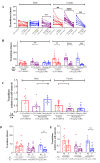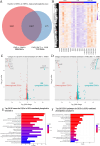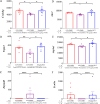Gender-different effect of Src family kinases antagonism on photophobia and trigeminal ganglion activity
- PMID: 39390364
- PMCID: PMC11468534
- DOI: 10.1186/s10194-024-01875-3
Gender-different effect of Src family kinases antagonism on photophobia and trigeminal ganglion activity
Abstract
Background: Src family kinases (SFKs) contribute to migraine pathogenesis, yet its role in regulating photophobia behaviour, one of the most common forms of migraine, remains unknown. Here, we addressed whether SFKs antagonism alleviates photophobia behavior and explored the underlying mechanism involving hypothalamus and trigeminal ganglion activity, as measured by the alteration of neuropeptide levels and transcriptome respectively.
Methods: A rapid-onset and injury-free mouse model of photophobia was developed following intranasal injection of the TRPA1 activator, umbellulone. The role of SFKs antagonism on light aversion was assessed by the total time the mouse stays in the light and transition times between the dark and light compartments. To gain insight to the preventive mechanism of SFKs antagonism, hypothalamic neuropeptides levels were assessed using enzyme linked immunofluorescent assay and trigeminal ganglion activity were assessed using RNA-sequencing and qPCR analysis.
Results: SFKs antagonism by a clinically relevant SFKs inhibitor saracatinib reduced the total time in light and transition times in male mice, but not in females, suggesting SFKs play a crucial role in photophobia progressing and exhibit a male-only effect. SFKs antagonism had no effect on hypothalamic calcitonin gene-related peptide and pituitary adenylate cyclase-activating polypeptide levels of all mice investigated, suggesting the gender-different effect of saracatinib on light aversion appears to be independent of these hypothalamic neuropeptide levels. In trigeminal ganglion of male mice, photophobia is associated with profound alteration of differentially expressed genes, part of which were reversed by SFKs antagonism. Subsequent qPCR analysis showed SFKs antagonism displayed gender-different modulation of expression in some candidate genes, particularly noteworthy those encoding ion channels (trpm3, Scn8a), ATPase signaling (crebbp, Atp5α1) and kinase receptors (Zmynd8, Akt1).
Conclusions: In conclusion, our data revealed that SFKs antagonism reduced photophobia processing in male mice and exhibited gender-different modulation of trigeminal ganglion activity, primarily manifesting as alterations in the transcriptome profile. These findings underscore the potential of SFKs antagonism for allieving photophobia in males, highlighting its value in the emerging field of precision medicine.
Keywords: Gender; Light aversion; Migraine; Src family kinases; Transient receptor potential ankyrin 1; Trigeminal ganglion.
© 2024. The Author(s).
Conflict of interest statement
The authors declare no competing interests.
Figures







References
-
- Oakley CB, Kossoff EH (2014) Migraine and epilepsy in the pediatric population. Curr Pain Headache Rep 18:402. 10.1007/s11916-013-0402-3 - PubMed
-
- MacGregor EA, Migraine (2017) Ann Intern Med 166:ITC49–ITC64. 10.7326/AITC201704040 - PubMed
-
- Wang Y, Wang S, Qiu T, Xiao Z (2022) Photophobia in headache disorders: characteristics and potential mechanisms. J Neurol 269:4055–4067. 10.1007/s00415-022-11080-4 - PubMed
MeSH terms
Substances
Grants and funding
LinkOut - more resources
Full Text Sources
Miscellaneous

